|
|
||
|
|
Troubleshooting With Select Aquatics Fish Fixit: Common Diseases, Health Issues |
|
|
|
||
|
||
|
|
|
|
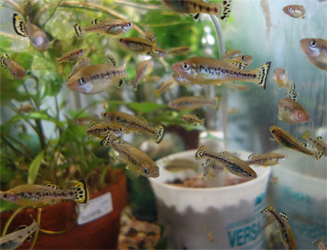
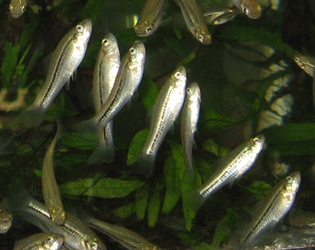
|
When
observing your fish for overall health, look closely at their fins. They should be clear of spots or cloudiness, and held out wide. If there is a problem starting in your tank, the fins are often the first place you will notice it. Then look to be sure their skin and eyes are smooth and clear of bumps or excess slime. On the far left are Ilyodon furcidens, and a growing out group of Xiphophorus montezumaes were caught waiting to be fed. |
|
|
This section
won't be quite as comprehensive, simply because much
of what we do - keeping the tanks
consistently clean,
Medications available in the fish pet trade are always evolving,
and there are over the counter remedies sold at fish and pet stores |
|
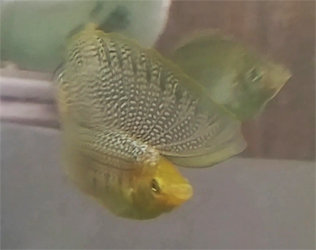
|
Even
without clear signs of a problem, the circumstances toward a |
|
|
When faced with a disease, isolate the affected fish to a
separate tank if possible, and be aware that your goal is not
first to treat
Many problems can be first addressed through performing an
immediate 40-50% water change, then providing a medicinal dose
of
1. Checking to
ensure that the temperature
is correct, |
|
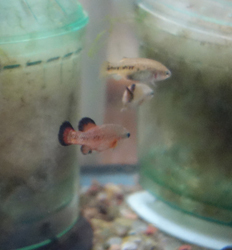
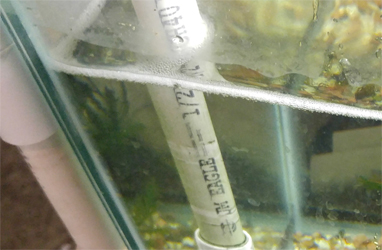
|
When
water conditions deteriorate,
the fish's immune system is challenged, and the fish becomes stressed and vulnerable to opportunistic infections. Generally, the fish are able to fend these off. Most disease outbreaks are the direct result of inconsistent or deteriorating conditions, or having an active disease introduced to a tank. Obvious signs will present themselves before an outbreak occurs, such as filter floss that is allowed to become too dirty or clogged, or foam accumulating at the water surface, which tells you that dissolved organic waste has built up to levels that are bad for the fish. For the tank at right, a water change needs to be done. |
|
|
How long do I have to address a problem,
before fish start dying?- When we get sick, we feel
the sickness coming on,
Aren't there more diseases than what's
mentioned here?- Yes, but the majority of the common
issues you will run |
|
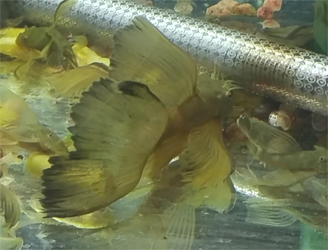
|
Some fish,
because of traits that have been bred into them, such as the
exaggerated finnage seen on this Green Dragon male, can be vulnerable to infection. Fancy guppies, in particular, are prone to fungus infections, and many IFGA show breeders maintain them in water that always contains a medicinal level of salt for this reason. With the Green Dragons, however, they have proven to be very disease resistant, and though they will often tear their fins up when breeding, they have always healed without incident. Any fish with lots of finnage needs to be watched for signs of spots, injuries, cloudy areas or clamping, that when spotted early can be treated quickly and easily without losses or permanent damage to the fins. |
|
|
Is it necessary to set up a Quarantine tank for new fish?-
Absolutely, and for one reason you may not expect. It is
always possible The
fish are bloated or swollen up- This will occur
occasionally, and when it happens it is generally an
internal infection that
Refusing to eat can also be an indication that the fish is
either sick or possibly harboring parasites. Do any necessary
cleaning in
For other internal parasites, there are medications available
that may be necessary to cure the fish afflicted, and often a The fish has
tufts of white on their mouths or fins- This is a
fungal infection, and if left untreated is fatal. Fortunately,
The fish have small white spots on their body
and fins - This is most likely
ich. Congratulations!
Your fish have the most
|
|
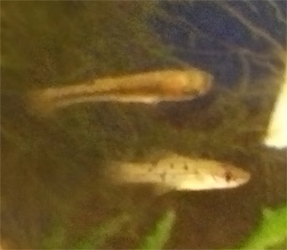
|
This is what "Livebearer Disease" looks like. When not too badly
affected, |
|
|
What is a
“Medicinal Dose” of salt?- One tablespoon of salt to
every 5 gallons of water. A 10 gallon tank would get 2
Can I mix medications? - Using any
medication should be considered carefully. As mentioned earlier,
the proper medication
Did a correct water change, but next day half of the fish
were
dead - In 4 places where I have lived and kept aquariums,
two
Do pathogens always exist in the tank? Or can you keep your
tanks "Clean"? This has been a topic of discussion for years,
I
happen to believe that pathogens always exist in our tanks - I
have had things come in with commercially prepared dry foods
Can I just maintain a medicinal dose of salt to avoid disease? Yes,
but there are reasons why this is not a good idea.
What causes bent spines? Bent spines are not a
disease, or even
a concern, with the exception of keeping that
fish from
Greg Sage
|
|
|
|
|